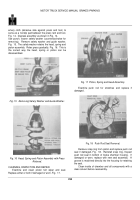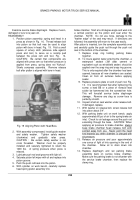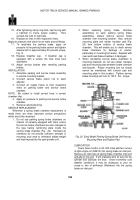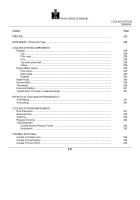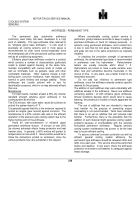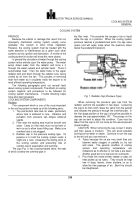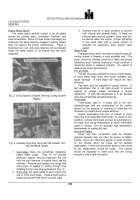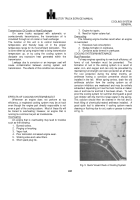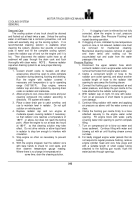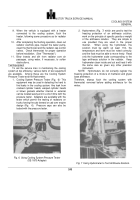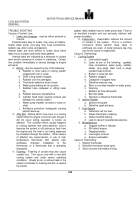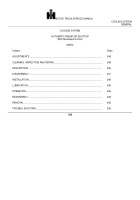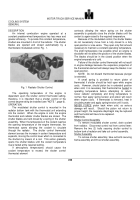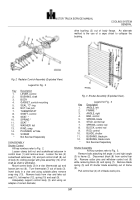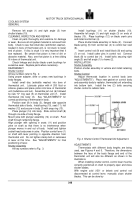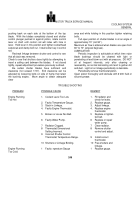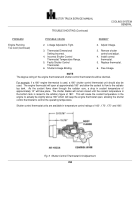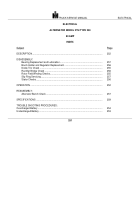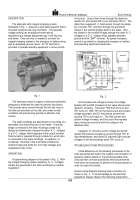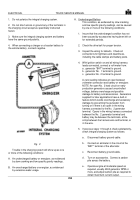TM-5-3805-254-14-P-2 - Page 248 of 894
MOTOR TRUCK SERVICE MANUAL
COOLING SYSTEM
GENERAL
TROUBLE SHOOTING
Causes of Coolant Loss:
1. Leaks and seepage - may be either external or
internal.
External leaks easy to locate, may occur at radiator,
heater, water pump, core plug hole, hose connections,
radiator cap, drain cocks, and gaskets.
Internal leaks are more difficult to locate since these
leaks occur at cracks and faulty head gaskets.
Internal leaks are indicated by a decrease in coolant
level and the presence of coolant in crankcase.
Correct
this condition immediately or serious damage to engine
will result.
2. Boiling - may be caused by any of the following:
a.
Radiator or other parts of cooling system
clogged with rust or scale.
b.
Grille or bug screen clogged.
c.
Radiator core fins damaged.
d.
Thermostat defective stuck closed.
e.
Water pump leaking air into system.
f.
Radiator hose collapsed or rotting inwar
dly.
g.
Radiator pressure cap defective.
h.
Cylinder head loose causing exhaust gas
leakage into cooling system.
i.
Water pump impeller corroded or loose on
shaft.
j.
Antifreeze protection inadequate causing
partial freeze-up.
3. After-Boil - Boiling which may occur in a cooling
system after the engine is shut off even though it
did not occur during operation is known as
afterboil.
This condition which usually happens
to cooling systems that need attention, occurs
because the coolant is still picking up heat from
the engine and the heat is not being dispersed
by circulation through the radiator.
Other causes
of afterboil are overprotection or use of high
temperature
thermostat
with
alcohol
type
antifreeze,
improper
installation
of
the
thermostat, or a thermostat that is operating
improperly.
4. Foaming - Foaming of coolant may also cause
coolant loss.
This occurs only with a very dirty
cooling system and under severe operating
conditions.
Usually an air or exhaust leak in the
system contributes to foaming and this is caused
by a faulty
gasket, leaky radiator hose or water pump seal.
Foam is
an excellent insulator and can seriously interfere with
proper circulation.
5. Evaporation - Evaporation reduces the amount
of coolant in the system.
This is a common
occurance where alcohol base types of
antifreeze are used.
A faulty pressure cap may
also be the cause of evaporation.
Cause of Overheating:
1.
Cooling System
a.
Low coolant supply
b.
Leaks at any of the following:
gaskets,
hose connections, water pump, radiator,
heater, core plugs, drain cock or plugs,
cracked head or block.
c.
Broken or loose fan belt.
d.
Radiator clogged.
e.
Collapsed or clogged hose.
f.
Defective pressure cap.
g.
Worn or corroded impeller on water pump.
h.
Foaming.
i.
Radiator air flow obstructed.
j.
Bent fan blade.
k.
Improper or defective thermostat.
2. Ignition System
a.
Ignition timing late.
b.
Defective spark advance.
3. Fuel System
a.
Carburetor set too lean.
b.
Valves timed late or leaking.
c.
Intake manifold leaking.
d.
Leak in vacuum operated accessories.
4. Miscellaneous
a.
Clogged muffler or tail pipe.
b.
Stiff rebuilt engine.
c.
Dragging brakes.
d.
Low engine oil level.
e.
Engine overloaded.
Cause of Overcooling:
1. Missing thermostat.
2. Defective thermostat stuck open.
3. Short runs and intermittent driving.
244
Back to Top

